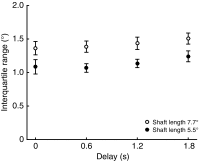Keeping a target in memory does not increase the effect of the Müller-Lyer illusion on saccades
- PMID: 26686530
- PMCID: PMC4785202
- DOI: 10.1007/s00221-015-4520-5
Keeping a target in memory does not increase the effect of the Müller-Lyer illusion on saccades
Abstract
The effects of visual contextual illusions on motor behaviour vary largely between experimental conditions. Whereas it has often been reported that the effects of illusions on pointing and grasping are largest when the movement is performed some time after the stimulus has disappeared, the effect of a delay has hardly been studied for saccadic eye movements. In this experiment, participants viewed a briefly presented Müller-Lyer illusion with a target at its endpoint and made a saccade to the remembered position of this target after a delay of 0, 0.6, 1.2 or 1.8 s. We found that horizontal saccade amplitudes were shorter for the perceptually shorter than for the perceptually longer configuration of the illusion. Most importantly, although the delay clearly affected saccade amplitude, resulting in shorter saccades for longer delays, the illusion effect did not depend on the duration of the delay. We argue that visually guided and memory-guided saccades are likely based on a common visual representation.
Keywords: Dorsal visual stream; Gaze; Variability; Ventral visual stream; Vision.
Figures



References
-
- Bertulis A, Surkys T, Bulatov A, Bielevičius A. Temporal dynamics of the Oppel-Kundt Illusion compared to the Müller-Lyer Illusion. Acta Neurobiol Exp (Wars) 2014;74:443–455. - PubMed
-
- Binsted G, Elliott D. The Müller-Lyer illusion as a perturbation to the saccadic system. Hum Mov Sci. 1999;18:103–117. doi: 10.1016/S0167-9457(98)00038-4. - DOI
-
- Brownell K, Rolheiser T, Heath M, Binsted G. Does perception asymmetrically influence motor production in upper and lower visual fields? Mot Control. 2010;14:44–58. - PubMed
Publication types
MeSH terms
LinkOut - more resources
Full Text Sources
Other Literature Sources
Medical

